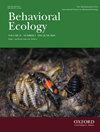Neighbors affect vocal behavior of tropical wrens: a multi-speaker density-manipulation experiment
IF 2.2
3区 环境科学与生态学
Q2 BEHAVIORAL SCIENCES
引用次数: 0
Abstract
For territorial animals, the behavior of conspecific neighbors sets the social context of communication. Despite numerous investigations of vocalizations related to territory defense and mate attraction, the effect of neighbor density on animal vocal behavior has received little attention, particularly in tropical animals and animals where both sexes produce complex acoustic signals. In this study, we used an innovative multi-speaker playback experiment to manipulate the apparent density of neighbors in rufous-and-white wrens, Thryophilus rufalbus, living in Costa Rica’s tropical dry forest. In this tropical songbird, both males and females, defend year-round territories and sing complex, learned songs for territory defense. We recorded singing behavior of 24 subjects (12 pairs) and then we used an array of six loudspeakers to simulate the presence of six new territorial neighbors (3 simulated pairs) outside each subject pair’s breeding territory. The stimuli persisted for three consecutive days with both male and female songs broadcast at a natural rate from dawn to dusk. We found that mean male song rate increased by almost fifty percent in response to the simulated increase in local density. Females showed less frequent song-type switching rates following the simulated increase in local density, although it was a marginal increase. These findings reveal that male and female songbirds’ vocal behavior varies with local density of territorial neighbors. We conclude that birds are sensitive to acoustic signals of conspecific density arising from sounds beyond their territory boundaries, and that they use this public information to guide their vocal behavior.邻居影响热带鹪鹩的发声行为:多扬声器密度操纵实验
对于有领地的动物来说,同种邻居的行为设定了交流的社会背景。尽管对与领地防御和配偶吸引相关的发声进行了大量研究,但邻居密度对动物发声行为的影响却很少受到关注,尤其是在热带动物和雌雄动物都能发出复杂声音信号的情况下。在这项研究中,我们使用了一种创新的多扬声器回放实验来操纵生活在哥斯达黎加热带干旱森林中的红白鹪鹩(Thryophilus rufalbus)的邻居表观密度。在这种热带鸣禽中,雄鸟和雌鸟全年都在保卫领地,并为保卫领地而演唱复杂、习得的歌曲。我们记录了 24 个受试者(12 对)的歌唱行为,然后使用由六个扬声器组成的阵列来模拟在每对受试者的繁殖领地外出现的六个新领地邻居(3 对模拟对)。刺激连续持续三天,从黎明到黄昏,雄鸟和雌鸟都以自然的速度鸣唱。我们发现,雄鸟的平均鸣唱率随着模拟的本地密度增加而增加了近百分之五十。雌性在模拟当地密度增加后的歌曲类型转换频率较低,但增加幅度不大。这些研究结果表明,雄性和雌性鸣禽的歌唱行为会随着当地领地邻居密度的变化而变化。我们的结论是,鸟类对来自其领地边界以外声音的同种鸟密度的声学信号很敏感,并且它们会利用这些公共信息来指导它们的歌唱行为。
本文章由计算机程序翻译,如有差异,请以英文原文为准。
求助全文
约1分钟内获得全文
求助全文
来源期刊

Behavioral Ecology
环境科学-动物学
CiteScore
5.20
自引率
8.30%
发文量
93
审稿时长
3.0 months
期刊介绍:
Studies on the whole range of behaving organisms, including plants, invertebrates, vertebrates, and humans, are included.
Behavioral Ecology construes the field in its broadest sense to include 1) the use of ecological and evolutionary processes to explain the occurrence and adaptive significance of behavior patterns; 2) the use of behavioral processes to predict ecological patterns, and 3) empirical, comparative analyses relating behavior to the environment in which it occurs.
 求助内容:
求助内容: 应助结果提醒方式:
应助结果提醒方式:


